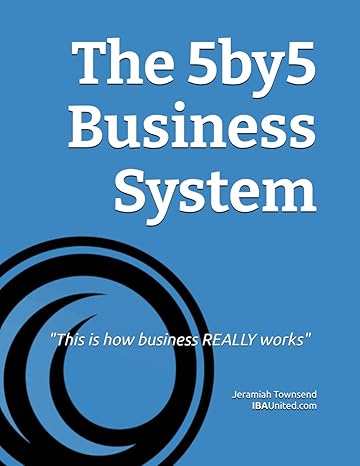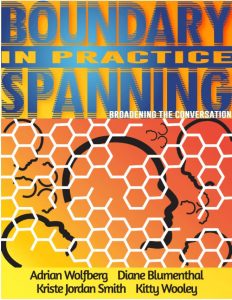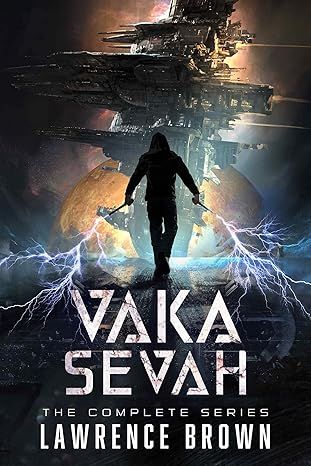Right up front let me advise you, if you are one of the many who don’t do much religion: don’t be thrown off by the subtitle of Christian principles. You can translate that to any value set you like, because the point is that the business has to do more than just make money to satisfy your actual desires, whether they are philanthropic, social or lifestyle. So the method opens up by asking you to confirm to yourself what those ultimate goals are. Without those, the money isn’t enough to get you up every morning, year in and year out, to tend to your creation in the way it needs to survive and thrive.
In addition, the whole 5×5 method depends on backward planning (the author calls it “reverse engineering”) from that vision to ensure that all the company’s activities and people are aligned towards objectives that achieve those value-based goals. The method is called 5×5 because it has 5 basic components (vision, sales, products, team, and operations), and each component has 5 key activities of increasing complexity and impact. These work backward from the vision: first you need operations that deliver effectively, then a team that can operate that way, then products that meet customer needs now and into the future, and last (but by no means least) an effective way of selling those products to customers.

For small businesses, this may be a dramatic shift from the advice given by many internet gurus who advocate selling first and then “faking it until you make it”, i.e., kluging together a barely acceptable product to generate the funds to continue refining the offerings. But it is not an advocation of the paralysis by analysis (or complete chaos) that always follows when attempting to introduce highly-complex changes. Instead, the method calls for having the end goal in mind but taking one next step at a time towards to those goals.
Once you get past the value discussion, the remainder of the book contains action steps and tips that you have probably heard before in various training events, but – well, you wouldn’t be reading the book if you had already applied them! The combination of clear common-sense explanations, searingly honest case examples, and the organization of the widely-known truths into a simple, achievable structure may well inspire the reader to do something about it at last. For those few owners actively thinking about when to exit their businesses, if you don’t have these systems in place, you’re not likely to realize much of a sales price, if you are able to sell at all (over 80 percent of owners cannot). Take it in combination with the advice given in “The Business Value Booster System” also reviewed on this site (and published by Caltrop Press). It’s worth giving this approach a shot for the 18-36 months that it will take to get your business system off the ground and eventually get more profits into your pocket.
Here’s a link to the Amazon version: https://www.amazon.com/dp/B0DMWTBYXW

![Here's The Deal: Everything You Wish a Lawyer Would Tell You About Buying a Small Business by [Joel Ankney]](https://m.media-amazon.com/images/I/41l6+OnAAWL.jpg)

![The Old Boys by [McCarry, Charles]](https://images-na.ssl-images-amazon.com/images/I/51pjfVZFTDL.jpg) An excellent yarn about a group of former spies getting together for one last caper. The premises are an entertaining homage to several classics in this field – a central character who is declared to be dead but may not be, the mysterious jihadist who has also returned from the dead, and (surprisingly) a long-lost Gospel that could have enormous repercussions. This last item is in fact an enormously intriguing concept but it serves only as the omnipresent McGuffin; I should like to have seen it developed a lot further.
An excellent yarn about a group of former spies getting together for one last caper. The premises are an entertaining homage to several classics in this field – a central character who is declared to be dead but may not be, the mysterious jihadist who has also returned from the dead, and (surprisingly) a long-lost Gospel that could have enormous repercussions. This last item is in fact an enormously intriguing concept but it serves only as the omnipresent McGuffin; I should like to have seen it developed a lot further. This book is an introduction to Kitty Wooley’s “Senior Fellows” initiative to develop and maintain an ongoing network of public servants (loosely defined) who are willing and able to work across organizational and functional lines to improve both public services and the conditions under which they are provided.
This book is an introduction to Kitty Wooley’s “Senior Fellows” initiative to develop and maintain an ongoing network of public servants (loosely defined) who are willing and able to work across organizational and functional lines to improve both public services and the conditions under which they are provided.![The Phoenix Project: A Novel about IT, DevOps, and Helping Your Business Win by [Kim, Gene, Behr, Kevin, Spafford, George]](https://images-na.ssl-images-amazon.com/images/I/51zDZ1s4hCL.jpg)
![Pink Goldfish: Defy Normal, Exploit Imperfection and Captivate Your Customers by [Phelps, Stan, Rendall, David]](https://images-na.ssl-images-amazon.com/images/I/51IG1Lg%2BIKL.jpg) A very easy reading book, packed with real-company examples to prove the points around the idea that you do much better by being very good at what you’re good at than by trying to copy what the most venerated institution is able to afford to do (but usually doesn’t). For a small entity there are plenty enough potential customers to thrive by being great at your core offering and by turning less-effective elements into points of differentiation.
A very easy reading book, packed with real-company examples to prove the points around the idea that you do much better by being very good at what you’re good at than by trying to copy what the most venerated institution is able to afford to do (but usually doesn’t). For a small entity there are plenty enough potential customers to thrive by being great at your core offering and by turning less-effective elements into points of differentiation.
![The Widows of Malabar Hill (A Perveen Mistry Novel Book 1) by [Massey, Sujata]](https://images-na.ssl-images-amazon.com/images/I/51yfg1VG4yL.jpg) A very engaging tale of a newly-minted attorney in 1920s Bombay (now Mumbai). Purveen Mistry is Bombay’s first and only female attorney, which presents several professional drawbacks, but it has one huge advantage: access to the class of women, often very wealthy, who are walled off from outside society in a harem and allow no contact with any males except their husband. This book is the story of a will-and-trust situation (a complex one, given the three surviving wives) that turns into a murder investigation, for which our heroine is quite unprepared. It also provides interesting insights into the interplay between India’s superficially-tolerant religious factions and the social issues (but also some of the equalizing and stabilizing influences) resulting from the British occupation which had then been going on for over 150 years. The events of the book also provide an introduction to some aspects of the Parsee religion (Zoroastrianism) imported from Persia in the middle ages, although mostly the book addresses only a few of the more dramatic practices rather than a fuller exposition of that very interesting religion. This was read as an audio book, the quality of which was excellent, using several audio voices and tonalities to keep the characters distinct.
A very engaging tale of a newly-minted attorney in 1920s Bombay (now Mumbai). Purveen Mistry is Bombay’s first and only female attorney, which presents several professional drawbacks, but it has one huge advantage: access to the class of women, often very wealthy, who are walled off from outside society in a harem and allow no contact with any males except their husband. This book is the story of a will-and-trust situation (a complex one, given the three surviving wives) that turns into a murder investigation, for which our heroine is quite unprepared. It also provides interesting insights into the interplay between India’s superficially-tolerant religious factions and the social issues (but also some of the equalizing and stabilizing influences) resulting from the British occupation which had then been going on for over 150 years. The events of the book also provide an introduction to some aspects of the Parsee religion (Zoroastrianism) imported from Persia in the middle ages, although mostly the book addresses only a few of the more dramatic practices rather than a fuller exposition of that very interesting religion. This was read as an audio book, the quality of which was excellent, using several audio voices and tonalities to keep the characters distinct.